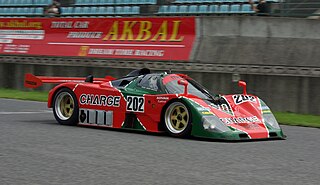
The Mazda 767/767B are prototype racing cars that were built by Mazdaspeed for the 24 Hours of Le Mans running under the IMSA-spec GTP class. The 767 replaced the 757 in 1988, upgrading to a newer and larger 4-rotor 13J Wankel engine which produced nearly 600 hp (450 kW).

The Jaguar XJ220 is a two-seat sports car produced by British luxury car manufacturer Jaguar from 1992 until 1994, in collaboration with the specialist automotive and race engineering company Tom Walkinshaw Racing. The XJ220 recorded a top speed of 217 mph (349 km/h) during testing by Jaguar at the Nardo test track in Italy. This made it the fastest production car from 1992 to 1993. According to Jaguar, an XJ220 prototype managed a Nürburgring lap time of 7:46.36 in 1991 which was faster than any production car lap time before it.
Tom Walkinshaw Racing (TWR) was a motor racing team and engineering firm founded in 1976, in Kidlington, near Oxford, England, by touring car racer Tom Walkinshaw.

The Jaguar XJR-9 is a sports-prototype race car built by Jaguar for both FIA Group C and IMSA Camel GTP racing. In 1988, Jaguar's XJR-9 won the 24 Hours of Le Mans, after debuting that year at the 24 Hours of Daytona.

Alvah Robert "Al" Holbert was an American automobile racing driver who was a five-time champion of the IMSA Camel GT series and the fifth driver to complete the informal triple Crown of endurance racing. He once held the record with the most IMSA race wins at 49.
John Lee Paul Jr. was an American racing driver. He competed in CART and the Indy Racing League competitions, but primarily in IMSA GT Championship, winning the title in 1982.

The Jaguar XJR sportscars were a series of race cars used by Jaguar-backed teams in both the World Sportscar Championship (WSC) Group C and the IMSA Camel GTP series between 1984 and 1993.
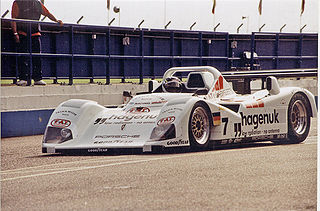
The Porsche WSC-95 was a Le Mans Prototype originally built by Tom Walkinshaw Racing. It was modified by Porsche from the original Group C Jaguar XJR-14 from which it derived, and run by Joest Racing. Originally intended to race in the IMSA World Sportscar Championship, the WSC-95 saw very little race action even though it won the 24 Hours of Le Mans in both 1996 and 1997 without being acknowledged as a factory supported project. It was later upgraded to the Porsche LMP1-98 before being retired. Only two cars were ever built.

The Jaguar XJR-12 is a sports-prototype race car built by the Jaguar Cars-backed Tom Walkinshaw Racing team for both Group C and IMSA Camel GTP. The XJR-12 is famous for winning the 1990 24 Hours of Le Mans race.
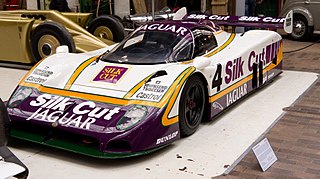
The XJR-8 was a race car built by Jaguar for campaigning in the World Sportscar Championship and the 24 Hours of Le Mans as part of Group C. It was used during the 1987 season.
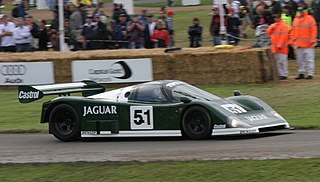
The Jaguar XJR-6 is a Group C sports prototype race car, designed, developed and built by TWR, with the aim of competing, from 1985, in the World Sportscar Championship. A total of six Jaguar XJR-6s were built and they contested in the World Sportscar Championship until 1986, before Jaguar replaced them with the Jaguar XJR-8.

The Jaguar XJR-10 is an IMSA GTP sports prototype race car, designed, developed, and built by TWR for Jaguar, with the aim of competing, from 1989, in the IMSA GT Championship. Jaguar XJR-10s competed until 1991, before Jaguar replaced it with the Jaguar XJR-16. The car debuted a new 3.0-liter twin-turbo V6 engine, which replaced the previous V12, and was later fitted to the Jaguar XJ220 as well.
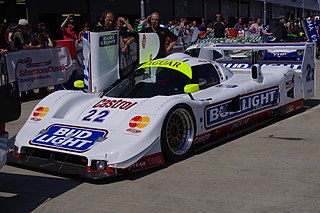
The Jaguar XJR-16 is an IMSA GTP sports prototype race car, with the aim of competing, from 1991, in the IMSA GT Championship. The Jaguar XJR-16s had a short lifespan, competing for only one season, before being hastily replaced with the Jaguar XJR-14.
The Jaguar XJR-17 was an IMSA Lights racing car, built by Tom Walkinshaw Racing. Rebuilt from a Jaguar XJR-16 for the IMSA Camel Lights, the XJR-17 never competed in the event due to funding issues and has since only been used in a few minor British events and historic races. It used a modified version of the XJR-16's 3.5-litre V6 engine, stripped of the twin-turbochargers and producing a claimed output of 450 hp, whilst its bodywork was cobbled together using various parts from older Jaguar XJR Sportscars.
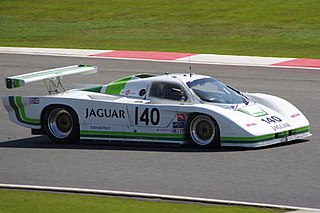
The Jaguar XJR-5 is a IMSA GTP sports prototype race car, designed, developed and built by Group 44 racing for Jaguar with the aim of competing, from 1982, in the IMSA GT Championship. Jaguar XJR-5s contested until 1985, before Jaguar replaced it with the Jaguar XJR-7.

The March 85G was a mid-engined IMSA racing sports prototype, designed and developed by March Engineering in 1984 and used in sports car racing until 1988.
The Alba AR6 was a Group C2 sports car prototype, designed, developed and built by Italian manufacturer Alba Engineering in 1985, to compete in the World Sportscar Championship, and used in sports car racing until 1990. A variant of the car, called the Alba AR8, was used in the IMSA GTP Championship.

The Argo JM19, and its derivatives/evolutions, the Argo JM19C, and the Argo JM19D, are a series of IMSA GTP Lights/Group C2 sports prototype, designed, developed, and built by British constructor Argo Racing Cars, for the IMSA GT Championship, introduced in 1985. Its use in sports car racing continued into the early 1990s. It won a total of 7 races, and scored a total of 21 podium finishes. It was powered by a number of different engines, including a Mazda 13B rotary engine, a Buick V6 turbo engine, a Ferrari V8 engine, and even a Ford-Cosworth DFL V8 Formula One-derived engine. It did, however, find most of its success when equipped with the Mazda-powered Wankel rotary engines.
The March 82G is a IMSA GTP/Group C sports prototype race car, designed, developed and built by British manufacturer and constructor March Engineering, for sports car racing, in 1982. It competed in motor racing between 1982 and 1986, but only scored 1 race win, 8 podium finishes, and 2 pole positions. It was powered by a naturally-aspirated 620 hp (460 kW) 5.7 L (350 cu in) Chevrolet V8 engine.

The V64V engine was a purpose-built and specially made 3.0 L (180 cu in) naturally-aspirated DOHC V6 engine, designed, developed and produced by Austin-Rover, for the MG Metro 6R4 Group B rally car, between 1985 and 1986.















